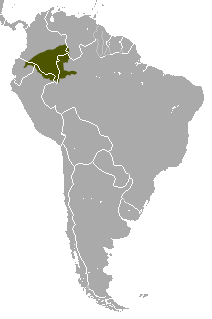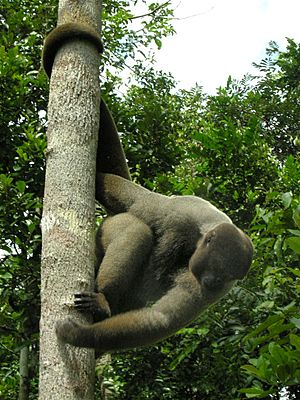Common woolly monkey facts for kids
Quick facts for kids Common woolly monkey |
|
|---|---|
 |
|
| Common woolly monkey in La Vallée des Singes, France | |
| Conservation status | |
| Scientific classification | |
| Genus: |
Lagothrix
|
| Species: |
lagothricha
|
| Subspecies | |
|
|
 |
|
| Range of type subspecies, L. lagothrica lagothrica | |
| Synonyms | |
|
|
The common woolly monkey is also known as the brown woolly monkey or Humboldt's woolly monkey. Its scientific name is Lagothrix lagothricha. This type of woolly monkey lives in parts of South America. You can find them in countries like Colombia, Ecuador, Peru, Bolivia, Brazil, and Venezuela.
Woolly monkeys live in groups that can have anywhere from two to 70 individuals. When they are busy looking for food or moving around, these larger groups often split into smaller ones.
Contents
About Their Names
Scientists sometimes disagree on how to classify animals. This is true for the common woolly monkey too. Some scientists think there are different types of woolly monkeys, while others see them as subspecies (smaller groups within one species).
Today, many experts agree that there are five different subspecies of the common woolly monkey. These are:
- Gray woolly monkey, L. l. cana
- Brown woolly monkey, L. l. lagothrica (This is the main type)
- Colombian woolly monkey, L. l. lugens
- Silvery woolly monkey, L. l. poeppigii
- Peruvian woolly monkey, L. l. tschudii
What They Look Like

Common woolly monkeys are quite large for monkeys that live in trees. Their bodies, not including their tails, are about 40 to 60 centimeters (1.3 to 2 feet) long. Their tails are even longer, measuring about 55 to 75 centimeters (22 to 30 inches). They can weigh between 5.5 and 10.8 kilograms (12 to 24 pounds).
Even though they are called "woolly monkeys," they are not always brown. They can also be gray or black. Their heads and undersides are usually darker. Their faces do not have fur and are typically black. Male woolly monkeys are usually bigger than females and have larger canine teeth. These monkeys are also diurnal, which means they are active during the day.
Where They Live
Common woolly monkeys live in the upper Amazon basin in South America. Their home range stretches from the Rio Tapajos in Brazil to eastern Peru, Ecuador, and Colombia. You can also find some groups further north in Venezuela. They used to live in Bolivia, but sadly, hunters have likely caused them to disappear from there.
These monkeys live in rainforests. They usually stay high up in the canopy, which is the top layer of the tallest trees. Sometimes, they might go down to the shrub layer. During certain seasons, groups might even enter flooded forests. This is because there are more berries there for them to eat.
What They Eat
Common woolly monkeys eat many different things, but they mostly eat fruit. They are called omnivores because they eat both plants and animals, but they are mainly frugivores (fruit-eaters). They especially like fruits that have one or two large seeds. They also prefer fruits that are lower in fat but higher in sugar and water.
They have favorite fruits, like those from the pea, fig, morning glory, and sapodilla families. These fruits make up about half of what they eat. However, the amount of fruit available affects their diet more than their preferences. When there isn't much fruit, they eat more leaves and insects instead. Female monkeys with babies tend to eat more leaves. This is probably because leaves have more protein, which helps them produce milk. Young woolly monkeys have been seen eating more insects than other group members.
How They Find Food
Common woolly monkeys are good at finding food. They spend a lot of time eating and moving to find food, traveling about 2 kilometers (1.2 miles) each day. They prefer fruit trees that grow in clumps and large trees. This is because these trees usually produce a lot of fruit, which means the monkeys don't have to travel as far between food spots.
Female monkeys with babies are better at finding food than young monkeys or adult males. When different groups of monkeys compete for food, the younger monkeys often get pushed away by adult males and females with babies. This means the younger monkeys end up eating more insects and leaves.
How They Interact
Female woolly monkeys often lead the relationships between males and females in their groups. Females do not usually mix with other females. Males, however, will interact with both sexes. Females can be protective of males and might bother other monkeys trying to interact with a male. Even though females are dominant within their own group, they are usually welcoming to new monkeys (both male and female) if there are no other females with babies present.
Moving Around and Spreading Seeds
Woolly monkeys use all four of their limbs when they walk, run, and climb. They are very good at using different branches, not just the very end ones, when climbing. They are also very important for spreading seeds. They are better at this than spider monkeys. This is because seeds stay in their digestive system longer, and they eat a wider variety of seeds. The fact that they eat insects also helps with seed dispersal.
Protecting Them
The common woolly monkey is listed as a vulnerable species by the IUCN. This means they are at risk of becoming endangered. They live in areas that are protected by national park laws, but also in areas that are not.
Dangers They Face
Even though the common woolly monkey lives in a wide area, it is considered vulnerable because of future threats. Human activities are the biggest danger to these monkeys. Building new highways through the Amazon rainforest is a big problem. These roads lead to more trees being cut down and more human activity in the forest. This makes the monkeys lose their homes and gives hunters easier access to the forest.
Hunting is a major threat, especially by local communities. Because woolly monkeys are large, they are easy targets for hunters. Sometimes, baby monkeys are sold as pets after their mothers are hunted. A baby monkey can be sold for about $80 USD. If woolly monkey populations keep shrinking, it could harm the whole ecosystem. They are important for spreading seeds and are part of the food chain as both predator and prey.
Conservation Efforts
Many national parks in South America have laws to prevent both deforestation and hunting. Some parks, however, do not forbid hunting. Parks and reserves that fully protect the brown woolly monkey include:
- Sumaco-Napo Galeras National Park
- Cayambe-Coca
- Cofán-Bermejo Ecological Reserve
- Cuyabeno Wildlife Reserve in Ecuador
- Nevado de Huila, Puracé, Cueva de los Guacharos and Picachos Natural National Parks in Colombia
- Majuna-Kichwa and Yaguas Reserved Zone in Peru
Some areas in Peru, like Algodón Medio Putumayo and Bajo Putumayo-Yagua, offer only partial protection. It is believed that the lack of hunting laws for local groups in some parts of Brazil led to the disappearance of these monkeys there.
See also
 In Spanish: Churuco para niños
In Spanish: Churuco para niños


